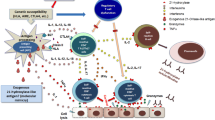Summary
Cerebrotendinous xanthomatosis (CTX) OMIM#213700 is a rare disorder of bile acid synthesis caused by deficiency of the enzyme sterol 27-hydroxylase. It results in deficiency of bile acids and accumulation of abnormal bile alcohols and accelerated cholesterol synthesis. CTX usually presents in the second or third decade with slowly progressive neurological dysfunction, cerebellar ataxia and premature atherosclerosis. Treatment with bile acid supplementation improves but does not completely reverse the neurological signs and symptoms. However, CTX is now known to be associated with a period of neonatal cholestasis. If it is diagnosed at this point, treatment may prevent the onset of neurological problems. We present the case histories and developmental findings in two affected siblings treated from infancy. We plan to continue regular neurodevelopmental reviews.


Similar content being viewed by others
Abbreviations
- CTX:
-
cerebrotendinous xanthomatosis
- HMG-CoA:
-
hydroxymethylglutaryl-coenzyme A
- WISC-III:
-
Wechsler Intelligence Scale for Children – third edition
- WPPSI:
-
Wechsler preschool and primary scale of intelligence
References
Andersson S, Davis DL, Dahlback H, Jornvall H, Russell DW (1989) Cloning, structure, and expression of the mitochondrial cytochrome P- 450 sterol 26-hydroxylase, a bile acid biosynthetic enzyme. J Biol Chem 264: 8222–8229.
Berginer VM, Salen G, Shefer S (1984) Long-term treatment of cerebrotendinous xanthomatosis with chenodeoxycholic acid. N Engl J Med 311: 1649–1652.
Clayton PT (2001) Applications of mass spectrometry in the study of inborn errors of metabolism. J Inherit Metab Dis 24: 139–150.
Clayton PT, Verrips A, Sistermans E, Mann A, Mieli-Vergani G, Weverrs R (2002) Mutations in the sterol 27-hydroxylase gene cause hepatitis of infancy as well as cerebrotendinous xanthomatosis. JIMD 25: 501–513.
Egestad B, Pettersson P, Skrede S, Sjövall J (1985) Fast atom bombardment mass spectrometry in the diagnosis of cerebrotendinous xanthomatosis. Scand J Clin Lab Invest 45: 443–446.
Garuti R, Croce MA, Tiozzo R, et al (1997) Four novel mutations of sterol 27-hydroxylase gene in Italian patients with cerebrotendinous xanthomatosis. J Lipid Res 38(11): 2322–2334.
Ko KF, Lee KW (2001) Cerebrotendinous xanthomatosis in three siblings from a Chinese family. Singapore Med J 42(1): 30–32.
Koopman BJ, Wolthers BG, Van der Molen JC, Waterreus RJ (1985) Bile acid therapies applied to patients suffering from cerebrotendinous xanthomatosis. Clin Chim Acta 152: 115–122.
Kuriyama M, Fujiyama J, Yoshidome H, et al (1991) Cerebrotendinous xanthomatosis: Clinical and biochemical evaluation of eight patients and review of the literature. J Neurol Sci 102: 225–232.
Kuriyama M, Tokimaura M, Fujiyama J, Utatsu Y, Osame M (1994) Treatment of cerebrotendinous xanthomatosis: effects of chenodeoxycholic acid, pravastatin and combined use. J Neurol Sci 125(1): 22–28.
Menkes JH, Schimschock JR, Swanson PD (1968) Cerebrotendinous xanthomatosis. The storage of cholestanol within the nervous system. Arch Neurol 19: 47–53.
Muhammed K, Nandakumar G, Saritha S (2006) Cerebrotendinous xanthomatosis: Need for early diagnosis. Indian J Dermatol 72(5): 364–366.
Nakamura T, Matsuzawa Y, Takemura K, Kubo M, Miki H, Tarui S (1991) Combined treatment with chenodeoxycholic acid and pravastatin improves plasma cholestanol levels associated with marked regression of tendon xanthomas in cerebrotendinous xanthomatosis. Metabolism 40(7): 741–746.
Russell DW, Setchell KD (1992) Bile acid biosynthesis. Biochemistry 31: 4737–4749.
Salen G (1971) Cholestanol deposition in cerebrotendinous xanthomatosis. A possible mechanism. Ann Intern Med 75: 843–851.
Salen G, Meriwether TW, Nicolau G (1975) Chenodeoxycholic acid inhibits increased cholesterol and cholestanol synthesis in patients with cerebrotendinous xanthomatosis. Biochem Med 14: 57–74.
Salen G, Batta AK, Tint GS, Shefer S (1994) Comparative effects of lovastatin and chenodeoxycholic acid on plasma cholestanol levels and abnormal bile acid metabolism in cerebrotendinous xanthomatosis. Metabolism 43(8):1018–1022.
Setchell KD, Heubi JE (2006) Defects in bile acid biosynthesis–diagnosis and treatment. J Pediatr Gastroenterol Nutr 43(Supplement 1): S17–22.
Setchell KD, O’Connell N, Russell D, Kelly DA (2000) A unique case of cerebrotendinous xanthomatosis in infancy with cholestastic liver disease further highlights bile acid synthetic defects as an important category of metabolic liver disease. In: XX International Bile Acid Meeting, 13–14 June, Amsterdam. Falk Symposium 165. [Abstract].
Setchell KD, Bove K, Heubi JE (2008) Disorders of bile acid synthesis. In: Walker WA, Goulet O, Kleinman RE, Sherman PM, Shneider BL, Sanderson IR, eds. Pediatric Gastrointestinal Disease. B C Decker Inc, Hamilton, ON. [In press].
Shefer S, Cheng FW, Dayal B, et al (1976) A 25-hydroxylation pathway of cholic acid biosynthesis in man and rat. J Clin Invest 57: 897–903.
Yasuhara H, Tonooka M, Kamei K, Sakamoto K (1985) Membrane effects of various drugs on isolated rat hepatocytes and erythrocytes. Toxicol Appl Pharmacol 79: 453–460.
Author information
Authors and Affiliations
Corresponding author
Additional information
Communicating editor: Peter Clayton
Competing interests: None declared
References to electronic databases: Cerebrotendinous xanthomatosis (CTX) OMIM#213700. www.ncbi.nlm.nih.gov/entrez/query.fcgi?db=OMIM; www.chem.qmul.ac.uk/iubmb/enzyme/; www.gene.ucl.ac.uk/nomenclature/.
Rights and permissions
About this article
Cite this article
Pierre, G., Setchell, K., Blyth, J. et al. Prospective treatment of cerebrotendinous xanthomatosis with cholic acid therapy. J Inherit Metab Dis 31 (Suppl 2), 241–245 (2008). https://doi.org/10.1007/s10545-008-0815-z
Received:
Revised:
Accepted:
Published:
Issue Date:
DOI: https://doi.org/10.1007/s10545-008-0815-z




